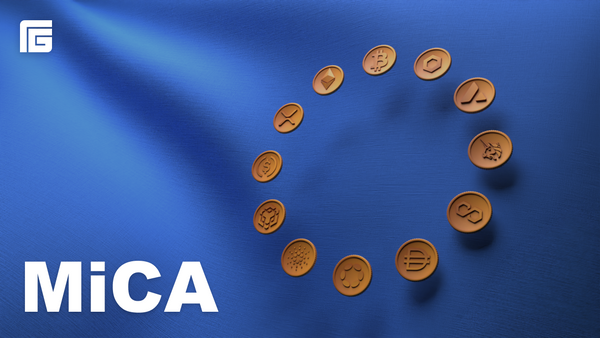What MiCA means for projects & investors

Over the last year, we have watched friends, fellow investors, and colleagues caught up in the collapse of FTX/Alameda and the ongoing domino effects. It all has that feeling of deja vu; we have been here before. At Faculty Group, we wanted to talk about financial regulation and, more importantly, our view on what the EU’s Market in Crypto Assets or MiCA will mean for projects, Traditional Finance (TradFi), and investors in the space.
MiCA is 380 pages of proposals and regulations around Markets in Crypto Assets agreed upon in October 2022. MiCA legislation will do what EU’s Directives on Markets in Financial Instruments (the much loved MiFIDI&II) did for banks and asset managers, for crypto assets and crypto asset providers. Although this regulation will not take effect until February 2024, it is essential to start thinking about how this will impact projects and how they interact with TradFi, banks, and investors going forward.
What MiCA will mean for projects
Projects will now have a legal obligation as persons issuing crypto assets or offering crypto assets to the public (token sales) to issue a ‘whitepaper’ (outlining the assets offered with legal disclosures and disclaimers) and follow guidelines for marketing crypto assets.
Assets in scope:
- E-Money tokens: assets whose value is pegged to one currency (like USDC)
- Asset Tokens (ARTs) - pegged to more than one fiat currency or any combination of different assets (e.g., other crypto assets or commodities, think crypto ETFs or Tether, for example)
- Crypto assets that do not fall under the other two or outside the scope of MiCA (Utility Tokens)
Assets not in scope:
- Assets that meet the requirements of already defined financial instruments (MIFIDI&II)
- NFTs (MiCA defines features that a token must have to be considered non-fungible)
- Loyalty tokens
For issuers of ARTs and e-money tokens, there will be requirements for keeping ‘own funds’ and ‘reserve assets’ (to meet the e-money directives related to initial capital and own funds), for prohibiting granting interest on assets, and for granting holders redemption rights on the underlying asset plans.
What MiCA will mean for CASPs
To operate in their chosen jurisdiction, all Crypto Asset Service Providers (CASPs) will need the relevant authorizations and regulatory approvals. They must meet governance, operational, complaint handling, and safekeeping of client funds requirements as well. Once authorized, entities/businesses will be entitled to passporting within the EU.
Any entity or business having one or more operational activities, including execution, custodial, exchange, order placing, transfer services, trading advice, and/or portfolio management of crypto assets, will be subject to financial regulation under MiCA. If these services are performed in a fully centralized TradFi way (covered under MiFIDI&II), then they are outside the scope of MiCA.
However, if any of the above activities or services are performed in a 'decentralized' way, MiCA applies. This means new technologies and products offered by firms will fall within the scope of financial regulation and operational risk management frameworks required by MiCA.
In summary, CASPs (and we would argue Projects) need to consider how the services they provide fall between these ‘two’ realms. To be fully centralized will mean falling under MiFIDI&II and firmly in TradFi, while being between web2 & web3 (not fully decentralized) will mean falling under MiCA.
What MiCA means for DeFi
Firstly, this is still very much up for discussion concerning what makes an entity fully decentralized. Today, most DeFi service providers still need to be fully decentralized but provide already regulated financial services (exchange, trading, derivatives, loans, etc.) through their ecosystems. These should fall under MiCA or current financial regulations for asset service providers in TradFi (because they hold clients' funds and provide services based on financial instruments).
When DeFi protocols are fully decentralized (for example, like Spool’s DAO or through a network like MakerDAO), these fall outside the scope of MiCA. However, further policy proposals are currently under discussion at the EU commission for DeFi regulation and financial monitoring. There is currently an EU pilot accepting applications to test automated Ethereum DeFi monitoring. This embedded supervision would automate DeFi data collection for regulators in real time.
Would any of this have prevented FTX’s collapse? In this case, having an unregulated centralized intermediary trading across multiple jurisdictions was a systemic risk for both institutional and retail investors. FTX as an exchange was not ‘regulated’ as a broker-dealer or custodian; even though FTX was heavily centralized in structure and funds, its services were designed to be outside TradFi and its regulatory structures. Many platforms provide ‘DeFi’ through centralized intermediaries (for fiat on-ramp, market making, exchange, custody, etc.) because it is an easy way to ‘achieve’ decentralized returns. However, it also carries huge market risk, as both projects and investors have learned the hard way.
We need to start regulating centralized intermediaries (CeFi) under current regulatory structures (for broker/, dealer, custodian), or we need to build a fit-for-purpose regulatory framework that can promote innovation while keeping client funds safe between these ‘two’ realms.








